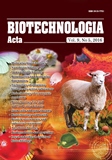"Biotechnologia Acta" V. 9, No 5, 2016
https://doi.org/10.15407/biotech9.05.018
Р. 18-23, Bibliography 11, English
Universal Decimal Classification: 615.017: 576.385.5

NANOCOMPOSITE COMPLEX EMAP II INFLUENCE ON TUMOR NECROSIS FACTOR AND INTERFERON
1 Institute of Molecular Biology and Genetics, of the National Academy of Sciences of Ukraine
2 Taras Shevchenko National University of Kyiv, Ukraine
3 Zabolotny Institute of Microbiology and Virology of the National Academy of Sciences of Ukraine
The goal of the research was to determine the ability of new nanocomposite preparation EMAP II (endothelial monocyte activating poplypeptide II) to affect the expression of the tumor-necrosis factor and interferon in vitro. In the experiments, the transformed cell line L929 cells was used. The induced interferon levels were determined in samples of culture medium by the microtitration method in the L929 cell culture against test virus vesicular stomatitus VSV. Toxicity of the substance was assessed by its maximum tolerated dose. The amount of endotoxins in nanocomposite preparation EMAP II was measured using gel-clot test. The range of concentrations of EMAP II causing the production of tumor necrosis factor was determined. The concentration of lipopolysaccharides in the tested nanocomposite preparation was less then 0.5 IEU/kg. New nanocomposite preparation EMAP II has the ability to induce TNF-α production at rather low concentration 1.56–25.00 ?g/ml (82.49–1370.00 mol х 10–12). The interferon production under the influence of nanocomposite preparation EMAP II was not found. The results support the application of the target nanocomposite reparation EMAP II for cancer treatment.
Key words: nanocompomposite EMAP II, tumor-necrosis factor TNF-α, interferon.
© Palladin Institute of Biochemistry of the National Academy of Sciences of Ukraine, 2016
References
1. Babenko L. A., Skorobogatov A. Iu., Dubrovsky A. L., Kornelyuk A. I. Bacterial expression optimisation of antitumor cytokine EMAP II in Escherichia coli BL21(DE3) pLysE cells. Microbiologiia i Biotechnologiia. 2010, V. 3, P. 21?31.(in Ukrainian).
2. Kornelyuk A. I., Babenko L. A., Kozlov A. V., Reznikov A. G., Chaikovska L. V., Polyakova L. І. Application for Invention «Nanocomposite anti-cancer agent». UA. Patent 17851 / ZU / 11, August 29, 2011.
3. Maini R. N., Taylor P. C. Anti-cytokine therapy for rheumatoid arthritis. Annu. Rev. Med. 2000, V. 51, P. 207–229.
4. Papadakis K. A., Targan S. R. The role of chemokines and chemokine receptors in mucosal inflammation. Inflamm. Bowel Dis. 2000, 6 (4), 303–313.
5. Locksley R. M., Killeen N., Lenardo M. J. The TNF and TNF receptor superfamilies: integrating mammalian biology. Cell. 2001, 104 (4), 487–501.
6. Berger A. S., Alexander H. R., Wu P. C. Tumour necrosis factor receptor I (p55) is upregulated on endothelial cells by exposure to the tumour-derived cytokine endothelial monocyte-activating polypeptide II (EMAP II). Cytokine. 2000, 12 (7), 992–1000.
7. Lans T. E., Van Horssen R., Eggermont A. M., Ten Hagen T. L. Involvement of Endothelial Monocyte Activating Polypeptide II in Tumor Necrosis Factor-alpha-based Аnti-cancer Тherapy. Anticancer Resh. 2004, 24 (4), 2243–2248.
8. Lazarenko L. N., Spivak N. Ya., Michaylenko О. М. HPV infection and interferon system . Titration interferon. Papillomavirusnaja infekcija i sistema interferona. Kyiv: Fitosociocentr. 2008, P. 237–238.(In Russian).
9. Dzjublik І. V., Trohimenko O. P., Krivohats'ka L. D. Micromethod etermination of tumor necrosis factor in the blood. Laboratorna dіagnostika. 2001, V. 4, P. 34–38. (In Ukrainian).
10. Kayton M. L., Libutti S. K. Endothelial monocyte activating polypeptide II (EMAP II) enhances the effect of TNF on tumor-associated vasculature. Curr Opin. Invest. Drugs. 2001, 2 (1), 136–138.
11. Van Horssen R., Joost A. P. Rens, Debby Schipper. EMAP-II facilitates TNF-R1 apoptotic signaling in endothelial cells and induces TRADD mobilization. Apoptosis. 2006, V. 11, Р. 2137–2145.

